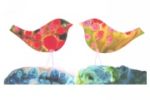AustLit

-
Kamishibai is a form of storytelling particular to Japan. Kamishibai literally means paper (kami) and theatre (shibai). Kamishibai rose to popularity in the 1930s during the Great Depression when previously unemployed men (although there were also a few women) rode by bicycle to various villages or parks and temples in towns and cities to present a series of stories to an audience. The main objective of the exercise was to sell candy to the children who came to hear the stories. The kamishibai man would set up his theatre on the back of his bike and bang together a pair of wooden clappers (hyoshige) to announce his arrival. The story was told via a series of story cards which were displayed through the 'theatre'. Coming together like this and listening to the story together engendered in the audience a feeling of kyokan which means shared or community feeling. As a point of contrast, as well as seeking similarities, this Exhibition also contains resources on other forms of storytelling and street performances such as puppet shows throughout Asia and the Punch and Judy shows so popular in the United Kingdom.
-
This interview appears in Carp Tales which is the newsletter for the Tokyo chapter of the Society of Children's Books Writers and Illustrators (SCBWI). Matsui explains how she had, at first, resisted kamishibai as she associated it with war propaganda. Once she realised its potential for performance and storytelling she embraced it as an art form which shares similarities with picture books but also has some quite different features as well.
-
What is Kamishibai?
This YouTube clip gives a step-by-step demonstration of how to perform a kamishibai storytelling. There is a good view of the three doors that are typical of the kamishibai theatre. It also explains how the cards work and why a kamishibai story works better for a group than a picture book.
//www.youtube.com/embed/v6URceEr_zc -
This online article explains what kamishibai is including an overview of the history of the rise (and decline) of kamishiba in Japan. Dym also looks at notions of kamishibai as performance art, nostalgia, and its relation to manga and anime.
-
This leaflet contains easy to follow instructions on how to make your own kamishibai storycards and tips for performing your kamishibai story.
-
A Kamishibai Performer
This YouTube clip is of a talented Japanese kamishibai storyteller. It is a particularly good example of how an enthusiastic teller really 'performs' the story using sound effects, different voices, and the sliding of the cards, particularly the 'partial slide'.
//www.youtube.com/embed/Pwbk6rzODoI -
This picture book is written and illustrated by Allen Say who is a well-known Japanese-American author/illustrator. In this picture book he recalls his childhood memories of the kamishibai man who kept the children entertained with his performances.
-
In this article Tara McGown reviews Eric Nash's book on Kamishibai in which he argues that kamishibai is a predecessor of the, now globally popular, Japanese art forms of manga and animé. He explains how the kamishibai performer would have presented episodes from several genres during each performance and how these genres have led to the astonishing array of characters, especially child-heroes, and subgenres also found in current manga and animé.
-
Puppet Theatre in Asia by Inge C. Orr published in Asian Folklore Studies Vol 33 No 1 (1974) pp. 69-84
This article gives an overview of the history of puppet theatre across a number of Asian countries. It shows puppetry's links to historical events and religious traditions. It also discusses a number of different forms of puppetry. Compare and contrast these developments with both kamishibai and the evolution of Punch and Judy puppet shows in the United Kingdom.
-
This article provides a number of points that are similar to the College of Professors article. Additionally, it raises points of similarity with some aspects of kamishibai. Both have their roots in former performance styles. The Punch and Judy puppeteer uses a drum and pan pipes to attract attention and the 'bottler' does the rounds of the crowd to gather donations. The kamishibai storyteller claps the hyoshige (wooden clappers) to attract attention and sells sweets to earn money. Similarly, each has been influenced by historical events and adversely affected by the rise in popularity of movies and television.
-
This article on the history of the Punch and Judy Show traces its origins from the arrival in England in seventeenth century of Puncinelia of the Italian Commedia Dell’ Arte art form to the present day. Over time the major transformation to occur was a change from stringed marionettes to gloved puppets. This change allowed the puppeteer to change from tent performances at fairs to become a street performer, and later, as the crowds flocked to the seaside by train, the Punch and Judy show became an institution at the seaside.
-
A Japanese re-telling of the Aboriginal legend about how the kangaroo got her pouch. (...more)See full AustLit entry
This text is made up of a number of story cards designed to be part of a kamishibai performance. The story is based on an Aboriginal legend of How the Kangaroo Got its Pouch.
You might be interested in...



